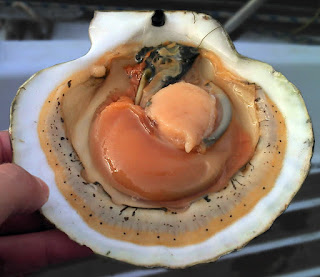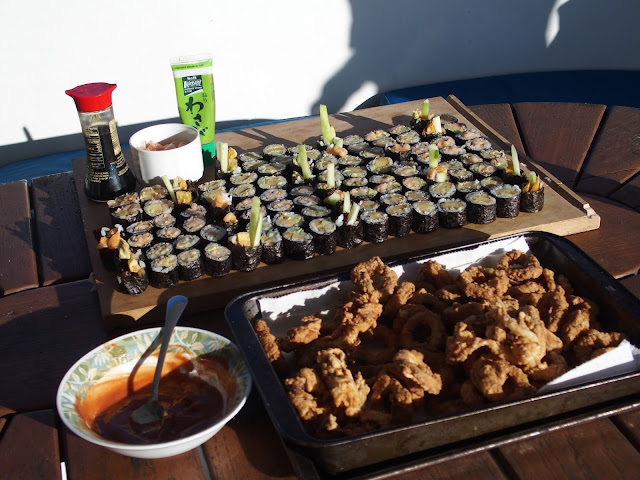Squid...It's What's for Dinner
 |
| Photo from hubpages.com |
On board, however, the sea has become our supermarket. And fresh? You can't get any fresher than hauling a tuna aboard and slicing off a piece of sashimi to nibble on while you fillet the rest. Again, I will say, I'm not an adventurous eater, but I'm willing to try anything. Well, sea turtle cooked in coconut milk? No way. (yes, this was offered to me on more than one occasion) Okay, almost anything.
Since visiting New Zealand, I have had my first tastes of raw oysters (not again... ever), steamed green-lipped mussels (yum!), and raw scallops (double yum!). Our palates are adjusting as we travel to far away places and jump on the "eat local" bandwagon. From ocean to science lab to table.
Here's a journal entry written by Michael about the day we caught our first squid...
“Field Trip, Field Trip. This is Perry,” comes Matt’s muffled voice on our radio.
“Perry. Field Trip,” Dad answers.
“Come over! We are catching squid off the stern with our squid jig.”
So Dad tells us to hop in the dinghy, and wait for him. He hops in.
“And we’re off!” I yell.
“Come aboard!” says Matt when we pull up behind their boat. As I step onto the transom, I notice a bucket full of… SQUID!
“Michael!” Conrad shouts to say hello. “Dad, can Michael have a turn fishing?”
“Michael, come on down and try!” says Matt. I shudder at the thought of taking a squid off the lure. But actually, I don’t have to take a squid off the lure, because I don’t end up catching one. Matt tries again himself, and quickly catches another. Unfortunately, when he puts the squid in the bucket - SPLAT! Dark black ink juts out of the squid’s ink sack, right onto Johnny’s bright orange shirt!
“Whoa,” said Johnny. “Squid tie-dye!”
We put one squid in a separate bucket to examine it. Its rubbery skin turns blue to match the bucket! When I touch it, its spots return. Johnny pets it like it is his new pet! We all keep imagining that it will torpedo out of the bucket at us with one squirt. “Target locked,” Mark says when it aims toward me.
 Squid are fascinating sea creatures. They belong to the Phylum Mollusca, but do not have an outer shell. They are more specifically cephalopods, related to the octopus. In relation to their body size, they have the largest eyeball in the animal kingdom. (In case you're wondering, no, I did not eat the eyeball.) They are believed to be the fastest invertebrate on Earth, using jet propulsion to dart away from predators. But the skin of the squid is what I find most amazing. Chromatophores in the skin allow them to change color and pattern in order to blend into their surroundings and communicate with each other. Bio-luminescent organs within the skin in some species enable them to glow and blink in various sequence. Our captured specimen gave us a beautiful display in the bucket as the kids cautiously, and not-so-cautiously, poked and prodded it.
Squid are fascinating sea creatures. They belong to the Phylum Mollusca, but do not have an outer shell. They are more specifically cephalopods, related to the octopus. In relation to their body size, they have the largest eyeball in the animal kingdom. (In case you're wondering, no, I did not eat the eyeball.) They are believed to be the fastest invertebrate on Earth, using jet propulsion to dart away from predators. But the skin of the squid is what I find most amazing. Chromatophores in the skin allow them to change color and pattern in order to blend into their surroundings and communicate with each other. Bio-luminescent organs within the skin in some species enable them to glow and blink in various sequence. Our captured specimen gave us a beautiful display in the bucket as the kids cautiously, and not-so-cautiously, poked and prodded it.Interestingly, the ink they squirted out all over Johnny and on the deck and stern steps of our friends' boat was more of a gel than I expected it to be. It was almost stringy. Just FYI for any boaters reading this - remove any squid ink with saltwater quickly before it has time to dry. If you don't get to it in time, the cleanser you use for your fiberglass should work, applied with a little elbow grease, of course ;). And the best tip I've learned for squidding? Always do it on someone else's boat!!!
 Later that day, Mark and Matt got together for a cold beer and lots of shucking - scallop shucking that is. They'd gone out the day prior to free dive for the "fillet mignon"of the sea and had found a vast bed of hundreds of them. Of course, there are specific regulations here on how many one can pillage and of what size. In New Zealand, one diver can take 20 scallops (at least 10 cm across) per person in the fishing vessel. That means if we happen to anchor the boat near a bed of scallops and Mark dives off the stern, he can pick up 80 legally. We didn't take nearly that many, but between both families, they had a fair amount of shucking to do!
Later that day, Mark and Matt got together for a cold beer and lots of shucking - scallop shucking that is. They'd gone out the day prior to free dive for the "fillet mignon"of the sea and had found a vast bed of hundreds of them. Of course, there are specific regulations here on how many one can pillage and of what size. In New Zealand, one diver can take 20 scallops (at least 10 cm across) per person in the fishing vessel. That means if we happen to anchor the boat near a bed of scallops and Mark dives off the stern, he can pick up 80 legally. We didn't take nearly that many, but between both families, they had a fair amount of shucking to do!  |
| Male bonding, cruiser style. |
 |
| Inside a scallop (Photo from Wikipedia) |
This was all new to us. We opened a shell and had to take a peek inside, trying to identify all of the parts. Along the outer edge, the scallop has about 60 little eyeballs that watch out for predators by detecting changes in light and movement. The adductor muscle (the part we would eat later) is the light colored circular portion that attaches the bottom shell to the top. The scallop uses this to open and close itself and shoot out jets of water for propulsion, a similar mode of locomotion to the squid. Incidentally, the squid and scallop are both mollusks, but unlike squid, they have an outer shell, putting them in the bivalve class. They are the only bivalves that can swim freely, although their 'swim' looks more like a 'clap'. One more fun fact... the dark orange organ is the female gonad, which is edible as well - mmmmm. And yes, I did try that bit, too!
 |
| Diagram courtesy of Pinterest |
Our friends, Matt and Jen, on SV Perry were our cooking instructors that evening. They did much of the sous chef work - making the rice (with rice vinegar and sugar added for taste and texture), slicing the veggies and prepping the squid. Then they taught us how to make a proper sushi roll and relayed tips from the galley about how to best bread calamari and fry it without any casualties; although, Matt did almost lose an eye to spitting hot oil. Thankfully, he escaped the galley - sight intact - in time to gaze upon the spread of sumptuous seafood that filled the table. With a quick toast to all the work that went into this meal and a nod to the fascinating creatures that would soon fill our bellies, we proceeded to absolutely chow down.
 |
| Why hadn't we learned how to do this before? |
 |
| Layering sushi rice, toasted sesame seeds, and chopped scallops coated in a sriracha/mayo sauce |
 |
| Now, that is FRESH! Let's eat! |






When do you start taking reservations for the five star restaurant? New Zealand has some of the best self collect sea food in the world. I introduced some cruisers to the thrill of collecting their own lobsters in that area. Rules are strict but the results mouthwatering. Better than any warm water crustacean.
ReplyDelete